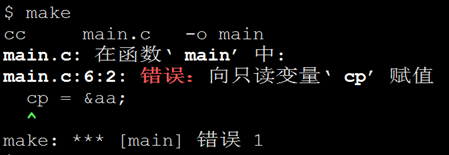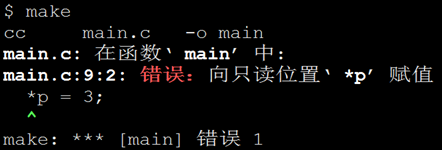By francis_hao Oct 31,2016
指针数组和数组指针
指针数组本身是个数组,数组的内容是指针。形如char *pa[]。由于[]优先级高于*,pa先于[]结合表示pa是一个数组,pa[]再与*结合表示pa[]是指针。比如pa[0]放了一个指针。
数组指针本身是个指针,指针指向的是数组。形如char (*ap)[6]。ap与*结合表示ap是个指针,(*ap)再和[6]结合表示(*ap)是个数组名,含有6个元素,可以把(*ap)[6]想成a[6],那么可以把(*ap)看成数组首地址a,而ap就是指向一个含有6个元素的数组的指针。
#include <stdio.h>
int main(void)
{
int aa[2][6]={{1,2,3,4,5,6},{7,8,9,10,11,12}};
int
(*pa)[6];
pa = aa;
//pa=&aa[0]; /*这样也是可以的*/
printf("%d
",*(*pa+1));
printf("%d
",**(pa+1));
return
0;
} |

首先共同点是他俩都是指针,只不过侧重点不同,放在前面的就是侧重的。
指针常量侧重于指针,说明指针本身是一个常量性质的,也就是说指针的值是不能改变的,指针常量的形式如:int *const a; 英语读作a const point to int。const放在谁后面就是修饰谁,说明*是const的,不能被修改,如下所示
#include <stdio.h>
int main(void)
{
int
*const cp;
int aa;
cp =
&aa;
/* 错误的,不能在除初始化处对cp进行赋值 */
return
0;
} |

只能在定义处赋初值
#include <stdio.h>
int main(void)
{
int aa;
int
*const cp =
&aa;
/* 正确的,只能在此处赋值 */
return
0;
} |
常量指针侧重于常量,说明指针指向的内容是常量,指针本身可以改变但是指向的内容不能改变,形式如:const int *a;或者int const *a;
英语读作a point to const int,记住,还是const在谁后面就修饰谁,如果在最前面就后移一位。
#include <stdio.h>
int main(void)
{
int aa;
const
int
*p;
aa =
1;
p =
&aa;
aa =
2;
*p =
3;
/* 错误的,不能对*p赋值 */
return
0;
} |

在上例中,并不是说aa所在地址的值不能改变了,只是不能通过指针p进行改变,更多的是向编译器进行的说明。
指针函数本身是个函数,具有一个指针类型的返回值.
函数指针本身是个指针,指向一个函数
函数指针由返回值确定类型,和参数无关,下面两段代码展示了这种特性
#include <stdio.h>
int fun1()
{
printf("fun1 without parameter but return int
");
return
0;
}
int fun2(char
*a)
{
printf("fun2 with parameter %s and return int
",a);
return
0;
}
void fun3(char
*a)
{
printf("fun3 with paramete %s but has no return value
",a);
}
int main(void)
{
int
(*pf)();
pf=fun1;
(*pf)();
pf=fun2;
(*pf)("sencond");
pf=fun3;
(*pf)("third");
return
0;
} |

只与返回值有关
#include <stdio.h>
int fun1()
{
printf("fun1 without parameter but return int
");
return
0;
}
int fun2(char
*a)
{
printf("fun2 with parameter %s and return int
",a);
return
0;
}
void fun3(char
*a)
{
printf("fun3 with paramete %s but has no return value
",a);
}
int main(void)
{
int
(*pf)();/*可以不考虑形参类型*/
void
(*ff)();
pf=fun1;
(*pf)();
pf=fun2;
(*pf)("sencond");
ff=fun3;
(*ff)("third");
return
0;
} |


本文由 刘英皓 创作,采用 知识共享 署名-非商业性使用-相同方式共享 3.0 中国大陆 许可协议进行许可。欢迎转载,请注明出处:
转载自:http://www.cnblogs.com/yinghao1991/p/6017894.html
参考
【1】 K&R C程序设计语言





